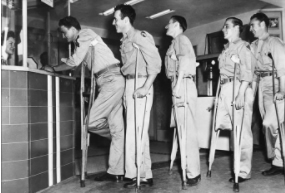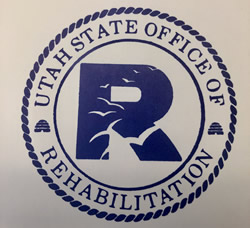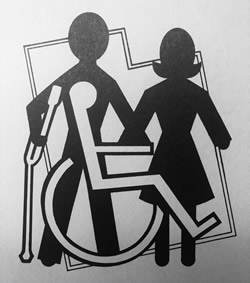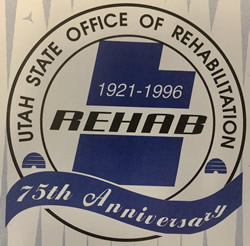Celebrating a Century of Vocational Rehabilitation and Services to People with Disabilities

2021 marks the 100th anniversary of the Utah State office of Rehabilitation (USOR). Utah has regularly led the nation in providing services for people with disabilities and holds the distinction of starting one of the first vocational rehabilitation programs in the country.
Vocational rehabilitation programs got their start in 1920 with the passage of the Smith-Fess Act (also known as the Civilian Vocational Rehabilitation Act) that established the Vocational Rehabilitation program for Americans with disabilities.
Utah and five other states set up a vocational rehabilitation program the following year in 1921. In the first two years of vocational rehabilitation in Utah, 50 residents with disabilities were successfully employed. Of those initial 50, 15 participants were blind and two who were deaf.
Before the first decade of vocational rehabilitation in Utah concluded, more than 1,000 Utahns were aided through the vocational rehabilitation program. In fact, from 1928 to 1930, a survey was conducted throughout Utah to increase awareness of vocational rehabilitation services. Anyone discovered through this process who met eligibility requirements was offered training through vocational rehabilitation.

As the U.S. entered World War II, the increasing demand for industrial production provided ample employment opportunities for those with disabilities. Attitudes of employers started changing during the war effort and businesses became more conscious that people with disabilities were very loyal, dependable and efficient workers.
In the post-war years, President Johnson’s Great Society formed domestic programs to address education, medical care, urban problems and rural poverty. Congress passed the Social Security Amendments of 1956, which created a Social Security Disability Insurance (SSDI) program for workers with disabilities aged 50-64. The Utah Division of Vocational Rehabilitation (predecessor to the Utah State Office of Rehabilitation) assumed responsibilities for disability determinations for the federal Social Security Administration programs.
In 1963, the Utah Legislature passed H.B. 218, which reorganized services for the blind. The Utah Commission for the Blind became the Utah Division of Services for the Visually Handicapped along with the Division of Vocational Rehabilitation (DVR). Together, these two divisions were commonly referred to as the Division of Rehabilitation.

Utah, once again, led the nation in 1969 by creating the Governor's Committee on Employment of People with Disabilities. This committee worked to support workforce integration of people with disabilities, along with educating employers on disability awareness, accessing hiring resources and supporting employment initiatives in local communities throughout the state. This mission continues today, in coordination with Utah State Office of Rehabilitation’s Business Relations Unit.
During the civil rights movements of the 1960s and ‘70s, disability advocates saw the opportunity to join forces alongside other minority groups to demand equal treatment, equal access and equal opportunity. Disability rights activists lobbied Congress and marched on Washington to include civil rights laws protecting people with disabilities. In 1973, congress passed the Rehabilitation Act of 1973. This Act redirected the vocational rehabilitation program making its first priority to serve individuals with significant disabilities. The program expanded to be more inclusive of individuals with developmental, intellectual and mental health disabilities. In addition, client involvement was stressed by requiring their involvement in the development of their Individualized Written Rehabilitation Plan (IWRP). The consumer had to sign the plan to indicate they understood it and approved. The Act authorized funding for demonstration independent living centers that could work with individuals regardless of a vocational outcome.
The signing of the Americans with Disabilities Act (ADA) in 1990 ensured equal access and equal treatment of people with disabilities. Modeled on the Civil Rights Act of 1964 and Section 504 of the Rehabilitation Act, the ADA created a framework for collective efforts by advocates in the preceding decades and is the most comprehensive disability rights legislation in history. Its employment provisions prohibit discrimination in job application procedures, hiring, advancement and termination. It also provided for equal access to workers' compensation, job training, and conditions and privileges of employment.

Throughout the ‘90s, Utah continued to lead the nation in services for people with disabilities. The Sanderson Center for the Deaf and Hard of Hearing opened in 1992 and continues to be one of the largest state-funded facilities in the nation. The Utah Center for Assistive Technology (UCAT) began in 1996 with a grant from the Utah Assistive Technology Program housed at Utah State University. UCAT continues to evaluate individuals with disabilities to find solutions using technology to help them overcome any barriers or limitations they may face. As the New Millennium dawned construction was completed on a new Center for the Blind and Visually Impaired. Co-located with the Utah State Library for the Blind, this facility is a one-stop center to help Utah residents who are blind or visually impaired and their families.
Today, the Utah State Office of Rehabilitation has assisted millions of people with disabilities in achieving their goals, increasing their independence and obtaining meaningful employment. USOR’s enduring success is due to the motivation of its clients, tireless efforts of its staff and support from the community. As USOR embarks on its next 100 years, it is committed to ongoing innovation to meet the evolving needs of its clients. To learn more about USOR’s services, please visit: jobs.utah.gov/usor